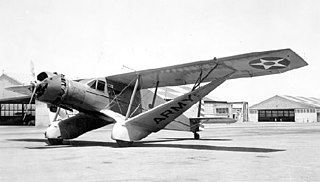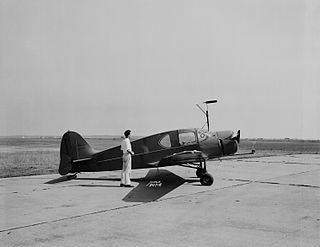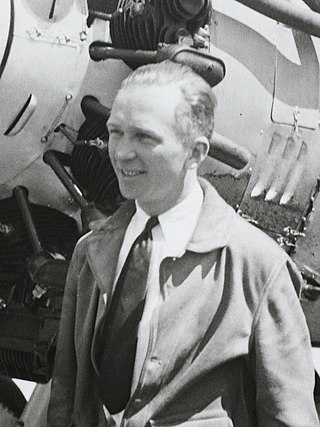The Curtiss-Wright Corporation is a manufacturer and services provider headquartered in Davidson, North Carolina, with factories and operations in and outside the United States. Created in 1929 from the consolidation of Curtiss, Wright, and various supplier companies, the company was immediately the country's largest aviation firm and built more than 142,000 aircraft engines for the U.S. military during World War II. Today, it no longer makes aircraft but makes many related components, particularly actuators, aircraft controls, valves, and surface-treatment services. It also supplies the commercial, industrial, defense, and energy markets; it makes parts for commercial and naval nuclear power systems, industrial vehicles, and oil- and gas-related machinery.

Wright Aeronautical (1919–1929) was an American aircraft manufacturer headquartered in Paterson, New Jersey. It was the successor corporation to Wright-Martin. It built aircraft and was a supplier of aircraft engines to other builders in the golden age of aviation. Wright engines were used by Amelia Earhart and Charles Lindbergh. In 1929, the company merged with Curtiss Aeroplane and Motor Corporation to form Curtiss-Wright.

Bertrand Blanchard Acosta was a record-setting aviator and test pilot. He and Clarence D. Chamberlin set an endurance record of 51 hours, 11 minutes, and 25 seconds in the air. He later flew in the Spanish Civil War in the Yankee Squadron. He was known as the "bad boy of the air". He received numerous fines and suspensions for flying stunts such as flying under bridges or flying too close to buildings.

The Bellanca Aircruiser and Airbus were high-wing, single-engine aircraft built by Bellanca Aircraft Corporation of New Castle, Delaware. The aircraft was built as a "workhorse" intended for use as a passenger or cargo aircraft. It was available with wheels, floats or skis. The aircraft was powered by either a Wright Cyclone or Pratt and Whitney Hornet engine. The Airbus and Aircruiser served as both commercial and military transports.

The Bellanca 14-7 Cruisair and its successors were a family of single-engined light aircraft manufactured in the United States from the mid-1930s onwards.

Clarence Duncan Chamberlin was an American pioneer of aviation, being the second man to pilot a fixed-wing aircraft across the Atlantic Ocean, from New York to the European mainland, while carrying the first transatlantic passenger.

Giuseppe Mario Bellanca was an Italian-American aviation pioneer, airplane designer and builder, who is credited with many design firsts and whose aircraft broke many aviation records. He was inducted into the National Aviation Hall of Fame in 1973. The Bellanca C.F., one of the world's first enclosed-cabin monoplanes, is on display at the National Air and Space Museum. Bellanca was known mostly for his long range aircraft which led the way for the advancement of international and commercial air transportation.

Charles Albert Levine was the first passenger aboard a transatlantic flight. He was ready to cross the Atlantic to claim the Orteig prize but a court battle over who was going to be in the airplane allowed Charles Lindbergh to leave first.

The Bellanca 14-13 Cruisair Senior and its successors were a family of light aircraft that were manufactured in the United States by AviaBellanca Aircraft after World War II. They were a follow-up to the prewar Bellanca 14-7 and its derivatives.

The Bellanca 19-25 Skyrocket II was a prototype light airplane built in the United States in the 1970s. Despite its advanced design and exceptionally good performance, it never achieved certification or entered production.

Enea Bossi Sr. was an Italian-American aerospace engineer and aviation pioneer. He is best known for designing the Budd BB-1 Pioneer, the first stainless steel aircraft; and the Pedaliante airplane, disputably credited with the first fully human-powered flight.

The Bellanca Airfield was an airfield, aircraft plant, and service hangar built in 1928 by Giuseppe Bellanca and Henry B. DuPont in New Castle, Delaware. Located off Route 273 near the Delaware River, the plant produced approximately 3000 aircraft before closing in 1954.
Maryland Pressed Steel Company was an American aircraft manufacturer of the Bellanca CD, and CE aircraft.

The Bellanca CE was the first aircraft designed for the Maryland Pressed Steel Company, by the aircraft designer Giuseppe Mario Bellanca. The aircraft was also called the Bellanca C.E. or the "CE Tractor Biplane".

The Wright-Bellanca WB-2, was a high wing monoplane aircraft designed by Giuseppe Mario Bellanca, initially for Wright Aeronautical then later Columbia Aircraft Corp.

The Wright-Bellanca WB-1 was designed by Giuseppe Mario Bellanca for the Wright Aeronautical corporation for use in record-breaking flights.

The Bellanca CF is an early enclosed high-wing monoplane designed by Giuseppe Mario Bellanca that led to a successful series of Bellanca aircraft. Bellanca was nominated for the Collier Trophy in 1922 for the CF design.

Aviation in Wisconsin refers to the aviation industry of the American Midwestern state of Wisconsin.

The history of aviation in Delaware begins with the first aeronautical event of the flight of Robie Seidelinger in an aircraft of his own design, the Delaplane, on 21 October 1910 at Wawaset Park, Wilmington.

The Lindbergh Boom (1927–1929) is a period of rapid interest in aviation following the awarding of the Orteig Prize to Charles Lindbergh for his 1927 non-stop solo transatlantic flight in the Spirit of St. Louis. The Lindbergh Boom occurred during the interwar period between World War I and World War II, where aviation development was fueled by commercial interests rather than wartime necessity. During this period, dozens of companies were formed to create airlines, and aircraft for a new age in aviation. Many of the fledgling companies funded by stock went under as quick as they started as the stock that capitalized them plummeted in value following the Wall Street Crash of 1929. The Great Depression dried up the market for new aircraft, causing many aircraft companies to go into bankruptcy or get consolidated by larger entities. Air racing, record attempts, and barnstorming remained popular, as aviators tried to recapture the prizes and publicity of Lindbergh's Transatlantic flight.

























